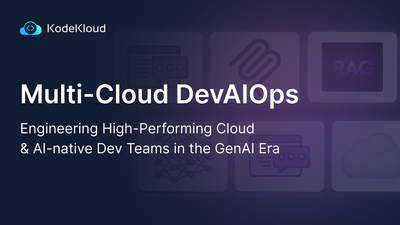As you introduce new product lines and features, hire more people, and add more tools to your tech stack, things start to break. Key DevOps metrics like MTTR and change lead time suffer.
We can blame these scaling issues on several things:
- Tightly coupled architecture
- Legacy tools and processes
- Limited multi-cloud visibility
- Too much customization
- Not enough automation
- Lack of clear standards
- Limited communication
Regardless of the causes, it’s best to fix these foundational issues before thinking about scaling your organization's DevOps practice.
What is Scalability in DevOps?
Scalability means being able to adjust the size of your resources based on current needs, ensuring you're never over or under-using what you have.
From a DevOps perspective, this flexibility improves four critical areas:
- Organizational performance: With flexible infrastructure, your organization can respond to market changes more rapidly, innovate faster, and gain a competitive edge.
- Team performance: Teams collaborate more effectively when they have access to resources that can scale up or down as needed. This flexibility reduces bottlenecks and eliminates waiting times for resources, allowing teams to focus on innovation and problem-solving.
- Software delivery: Being able to quickly provision and release resources enhances continuous integration and continuous delivery (CI/CD) pipeline efficiency, leading to faster software releases. It also enables teams to deliver fixes to customers at a higher velocity, boosting customer satisfaction and engagement.
- Operational performance: Flexible infrastructure makes systems more reliable and available by quickly adjusting to higher demand or operational issues.
To illustrate this flexibility, imagine managing server resources for a popular online game. On launch day or during special events, player numbers spike, requiring more server capacity to keep the game running smoothly for everyone. When player activity returns to normal levels, you can reduce server resources to save on costs without affecting performance.
This is the essence of flexible infrastructure in DevOps and where cloud computing can help.
When *not* to Scale DevOps
It can also be helpful to know when *not* to scale DevOps. You might want to hold off on scaling your DevOps practices if…
- You’re struggling with changes. Your systems should facilitate code changes, not hinder them. If changes risk breaking other systems, your current DevOps setup isn't robust enough to scale.
- You’re seeing more error rates. A higher number of errors in production code can indicate processes or tools are not ready to be scaled. High error rates can lead to downtime, customer dissatisfaction, and additional pressure on your DevOps team to perform "firefighting" instead of doing proactive work.
- Manual processes cause delays. When the manual parts of your continuous integration (CI) workflow or DevOps pipeline start to bog down release schedules, your systems need refinement before scaling.
- Teams are getting overwhelmed. Your DevOps processes should reduce the mental effort needed to manage your platforms and tools, not increase it. This includes simplifying processes, improving documentation, and ensuring tools are user-friendly and well-integrated. A high cognitive load can slow down decision-making, reduce efficiency, and lead to engineer burnout.
Investing in enhanced processes, automation, and team member capacity sets the stage for scaling DevOps successfully. This is where the “3 Ps” come into play.
The 3 Ps of Scaling DevOps
Scaling DevOps effectively comes down to three critical areas: people, processes, and platforms. Let's look at how they each play a role.
People
When scaling DevOps, the first big challenge is aligning the people involved. Getting everyone to agree on DevOps practices can be tough. It means encouraging teamwork, open communication, and a willingness to try new things.
However, changing how people think and work and getting buy-in are often the hardest parts of scaling DevOps principles. 21% of respondents at companies with mid-level DevOps maturity report that their culture discourages such risk.
At companies lower down the DevOps maturity scale, over half (54%) report seeing little momentum. Meanwhile, at companies with high DevOps maturity, 92% of respondents experience a lot of momentum behind DevOps implementation.
It’s clear that low organizational support and a risk-averse culture don’t help in scaling DevOps. The goal is to create a culture where everyone understands and believes in the benefits of DevOps.
However, big companies often have complex setups with different teams having their own goals, budgets, and priorities. For example, in many companies, the software development team, security team, and operations team work separately. This can slow things down, as each team has its own way of doing things.
Drawing in cross-functional teams to share responsibilities and focus on common goals can make a big difference in scaling DevOps initiatives. Naturally, this requires strong leadership. Leaders must articulate a clear vision for what DevOps aims to achieve within the organization and actively support the shift towards more collaborative, efficient practices.
Collaboration plays a big role. DevOps thrives on teamwork, so having the right tools to help everyone work together is essential. Whether that’s software that helps teams manage projects, chat apps for quick communication, or shared spaces for documentation, the right tools can break down barriers and speed things up.
Processes
When scaling DevOps, refining the delivery process is crucial. The way work gets done must be as smooth and efficient as possible.
A few things help here:
- Automation
- Documentation
- Faster decisions
- Monitoring and alerts
- Measurement and feedback
- Good governance
- Information sharing
A big part of scaling DevOps is reducing manual work through automation. This helps speed up tasks like testing and deploying new code changes.
For instance, DevOps automation can take care of repetitive tasks like setting up servers or checking code for errors. This frees up the team to focus on more important things, like improving the product.
Another key area is documentation. Good documentation helps everyone follow the same steps, which reduces confusion, mistakes, and support tickets.
Faster decision-making is also important. In some companies, every small change needs to be approved by several people, which can slow down the whole process. Having just one or two people checking the most important changes can speed things up.
Real-time system monitoring and incident management are other essential factors. If something goes wrong, the team should be able to spot and fix it quickly, ideally before it affects users. Implementing processes to remediate issues helps reduce change failure rates, improve MTTR, and reduce engineer burnout.
Then there’s measurement. Setting up ways to measure how often you deploy updates, how quickly you can make changes, and how fast you recover from errors can show you what needs improvement.
Good governance improves DevOps by guiding how software is made, tested, and shared. This helps keep quality high without slowing down the development process and provides an audit trail.
Good governance also plays into the need for security integration. Instead of being an afterthought, security should be part of the DevOps process from the start. This approach, often called DevSecOps, involves shifting security "left" or earlier in the software development process to identify and address vulnerabilities sooner.
Lastly, transparent information sharing helps everyone know what’s happening in the project and what went wrong or right. This helps teams learn from mistakes and avoid future occurrences.
Platforms and Tools
As your organization grows, your infrastructure must evolve to support the expansion. This often means investing in more DevOps tools and platforms, like cloud-based solutions and container technologies.
These innovations can help save money, meet fluctuating demands more efficiently, and make better use of resources. A typical set of tools might include:
- Continuous integration and continuous delivery (CI/CD) platforms
- Version control systems
- Monitoring and alerting software
- Configuration management tools
While each of these tools plays a crucial role, there's a lot to be gained from streamlining your toolset. By reducing the number of tools in use and ensuring proper integration, you can speed up deployment times, cut down on delays, and reduce the risk of errors. Check out the 10 Essential DevOps Tools You Should Learn in 2024
However, choosing the right tools and platforms isn't just about the latest and greatest tech. Many industries, like finance and healthcare, rely on legacy systems that are expensive to maintain and difficult to update or replace.
Finding ways to work with these older systems while still adopting modern DevOps practices is essential. This might mean creating interfaces that allow new tools to communicate with legacy systems or developing custom solutions that bridge the gap between old and new.
Imagine you work in a bank that uses a decades-old database system for customer transactions. Instead of replacing this system entirely — a costly and risky move — you could implement a series of microservices that interact with the legacy system.
These microservices could handle new functionalities, such as online banking features, while still relying on the core database for transaction processing. Such an approach allows the bank to offer modern services to its customers without the need to overhaul its entire IT infrastructure.
Budget Implications
Scaling DevOps across an organization doesn't necessarily mean you'll spend less money. The goal of DevOps is to add more value to your products, which can lead to higher revenue — but there are upfront costs to consider.
Investing in new technology, training your staff to use it, and integrating it with your existing systems can all be expensive. And it might take a while before you start seeing a return on these investments.
This initial phase can be challenging and will test the patience of your stakeholders, but it's important not to get discouraged if you don't see immediate results.
Scaling DevOps: Questions to Ask
As you consider scaling DevOps across your organization, here's what you should be asking:
- What's our company's DevOps maturity level? Are you just starting out, or do you already have processes and tools in place? Understanding where your organization sits in its DevOps journey helps identify the steps needed to scale effectively.
- What are the bottlenecks and improvement areas? Look for recurring issues that impede your workflow or cause delays. Identifying these can highlight where improvements are needed.
- Is our DevOps team structure optimal? Consider whether your current team structure supports DevOps practices. You might need to reorganize teams to foster better collaboration between developers, operations staff, and other roles. Skelton and Pais dive deeper into different DevOps team structures here.
- What's our tool stack, and what should we add or remove? Evaluate the DevOps tools you're using for development, testing, deployment, and monitoring. Determine if they meet your needs or if you need to introduce new tools and phase out non-needed ones.
- What's our timeline, and how much do we need to invest in scaling DevOps organization-wide? Consider the resources needed for DevOps training, tool acquisition, and potential restructuring efforts. Setting a realistic timeline for scaling DevOps and understanding the investment required (both time and money) helps with planning.
Answering these questions will provide a clear picture of your current position and what steps you need to take to scale DevOps within your organization.
The Role of Training in Scaling DevOps
A team that's knowledgeable and up-to-date with the latest DevOps practices will perform more efficiently and make fewer mistakes, leading to better outcomes and faster software delivery. Small teams of highly skilled experts might become overwhelmed quickly, while a larger team that is not well-trained will make more mistakes, increasing costs and slowing down progress.
The ideal scenario is a team that's not too big but highly skilled, with automation taking care of repetitive tasks. Making a compelling business case for team training can be challenging, but training is crucial for the long-term success of your DevOps initiatives.
Highlighting the ROI from training can help you make your case. Training not only improves efficiency and product quality but also plays a crucial role in staff retention.
Besides, providing opportunities for professional growth makes employees feel valued and helps retain top talent, which is essential for sustaining your DevOps efforts.
To support this growth, consider setting up clear career paths and mentorship programs within your org.
Mentorship programs can help less experienced team members learn from seasoned professionals, speeding up their development and ensuring they're more effective in their roles.
KodeKloud offers a range of courses designed to upskill DevOps engineers, covering everything from basic principles to advanced techniques.



















Discussion